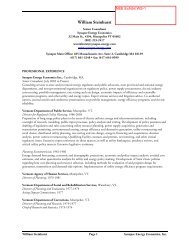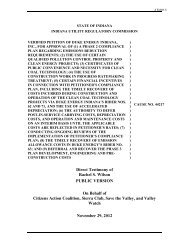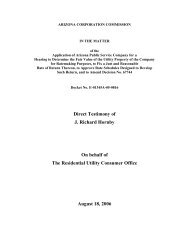Best Practices in Energy Efficiency Program Screening - Synapse ...
Best Practices in Energy Efficiency Program Screening - Synapse ...
Best Practices in Energy Efficiency Program Screening - Synapse ...
Create successful ePaper yourself
Turn your PDF publications into a flip-book with our unique Google optimized e-Paper software.
Table 3.1. Select T&D Avoided Cost Estimates (2011$/kW-year)<br />
Utility<br />
Avoided<br />
Transmission<br />
Avoided<br />
Distribution<br />
Total<br />
SDG&E, CA 20.5 n/a n/a<br />
SCE, CA 56.4 n/a n/a<br />
PG&E, CA 14.7 23.7 38.4<br />
PacifiCorp 31.9 83.2 115.1<br />
PGE, OR 10.8 22.4 33.2<br />
NSTAR, MA 15.0 89.0 104.1<br />
WMECo, MA 20.7 62.2 82.9<br />
National Grid, MA 20.4 111.6 132.0<br />
National Grid, RI 20.4 89.0 109.4<br />
CL&P, CT 1.3 29.7 31.0<br />
UI, CT 2.5 46.0 48.5<br />
3.5 Avoided Environmental Compliance Costs<br />
Introduction<br />
In theory, the Societal Cost test, the TRC test and the PAC test should all explicitly<br />
account for the avoided costs of compliance with environmental regulations. It is now<br />
common practice to account for the cost of comply<strong>in</strong>g with current environmental<br />
regulations, such as the costs of purchas<strong>in</strong>g SO2 and NOX allowances. However, it is<br />
much less common to fully account for the costs of comply<strong>in</strong>g with forthcom<strong>in</strong>g or future<br />
environmental regulations. Fail<strong>in</strong>g to do so skews the cost-effectiveness evaluations<br />
aga<strong>in</strong>st energy efficiency, can lead to significantly less energy efficiency than is costeffective,<br />
and can result <strong>in</strong> customers pay<strong>in</strong>g for alternative environmental compliance<br />
options that are much more expensive than energy efficiency resources.<br />
These avoided costs of environmental compliance should not be confused with avoided<br />
environmental externalities. Instead, these costs represent the anticipated costs that will<br />
be <strong>in</strong>curred by utilities <strong>in</strong> the future to comply with environmental requirements; costs<br />
that will eventually be passed on to ratepayers, and thus are clearly with<strong>in</strong> the def<strong>in</strong>itions<br />
of the TRC test and the PAC test, as well as the Societal Cost test.<br />
Summary of Current and Anticipated EPA Regulations<br />
The US Environmental Protection Agency (US EPA) has proposed and promulgated a<br />
number of environmental rulemak<strong>in</strong>gs that affect the operation of exist<strong>in</strong>g and new<br />
power plants under the Clean Air Act, the Clean Water Act, and the Resource<br />
Conservation and Recovery Act.<br />
The Clean Air Act is a comprehensive federal law that regulates air emissions from<br />
stationary sources such as chemical plants, steel mills, and electrical generators as well<br />
as mobile sources. Under this act, EPA sets emission standards for both stationary and<br />
| 26 <strong>Best</strong> <strong>Practices</strong> <strong>in</strong> <strong>Energy</strong> <strong>Efficiency</strong> <strong>Program</strong> Screen<strong>in</strong>g | www.nhpci.org







